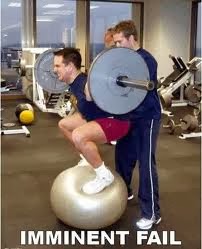http://www.bottomlinefitness.com/2013/05/26/how-to-get-killer-abs-cooking-with-coconut-oil/
While heavier weights with low reps should be safely built up to, EVERYONE should lift heavy if their goal is aesthetics. What dictates your results, based on your goals, is how much you eat. There is a simple maxim in lifting:
You want to be big? Lift heavy and eat lots.
It's not rocket science. But guess what? As lifting heavy burns more calories (7-9 rep range) than light lifting at 15 reps (the common conception of how to "stay lean"). If you eat less and eat clean, you will burn fat, but also maintain muscle tone. That's not to say you won't burn muscle as well, that is unavoidable when at a calorie deficit, but you will maintain a baseline of muscle tone if you eat properly.
If you are trying to gain mass, eat plenty of lean protein, plenty of veggies, and plenty of grain and nut based carbs. You will need to eat at least 1000 more calories than you burn in a day to add noticeable muscle. (The carbs are vital, because carbs are your primary energy source. If the body burns through all of your carbs, it moves on to protein as a secondary macro-nutrient energy source (ie. burns your muscle as energy).
If you are trying to get lean, eat lean proteins as well, but consume most of your carbohydrates as veggies. You can incorporate grains and nuts as well, but to lean out, you will need to run a calorie deficit each day. Consider a deficit of 1000 calories to be a safe goal, depending on how quickly you want to cut weight (remembering that 3500 calories burnt is roughly equal to a pound of fat).
Without further ado, here are the Big 5 exercises...the only ones you need to do to look like a beach hero: Squat, Deadlift, Bench Press, Seated Row, Military Shoulder Press
1) Squats
http://www.nerdfitness.com/blog/2009/07/08/why-you-need-squats-in-your-workout-and-how-to-do-them-right/
2) Deadlifts
http://fitness.makeupandbeauty.com/every-girl-needs-to-learn-to-dead-lift/
3) Bench Press
http://www.homeexercise.co/power-lifting/204/
4) Seated Rows
http://www.myfreckledlife.com/2013/10/03/bicep-blues/
5) Military Shoulder Press
http://fitfinity.net/2010/09/20/exercise-essentials-part-4-overhead-press/
Boom. That's it. 100 years of body building knowledge summed up into what every body builder already knows. If you are mindful of precise form, always actively engage your core in every exercise, and go until failure with heavy weight, you will get the results you want...guaranteed. Perform 4 sets of each, 7-9 reps, 4 days per week with one day of rest in between. You can even superset them for time-efficiency (Squats with Rows, Deadlifts with Bench, Military with Abs -- if you really want to -- although it's not necessary to isolate abs if you are doing the lifts right). Abs are a reflection of diet and form. If you absolutely must do cardio, do high intensity interval training. You will get far better results and a bigger bang for your buck then a standard jog.
So there it is...the secret is out! So you can continue to buy your body building and curve magazines and do those exercises (they are good to mix things up), but if you have the drive and commitment and don't easily get bored, the big 5 will get you the beach body you want.














